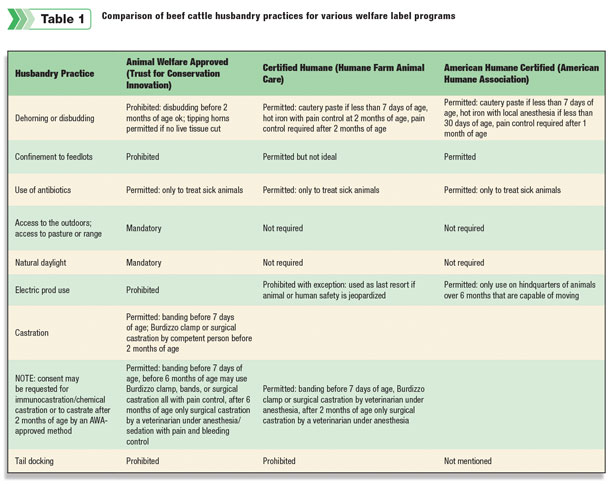It is important for shoppers to understand what a label means when choosing products that promote animal welfare or specific care practices.
However, it can be just as confusing for producers to make sense of all these options when determining new marketing opportunities for their cattle.
Click here or on the image above to view it at full size in a new window. (PDF 821KB)
A few of the top-recognized labels are discussed here. A brief outline of the husbandry practices that may require specific compliance is included (Table 1).
Weaning
Recommended weaning methods focus on current industry practices that minimize stress to the animals. Some suggested methods include fenceline weaning, use of nose tabs or mixing heifers or dry cows with calves.
It is preferred that calves suckle up to 6 months or at least not be weaned prior to 3 months old.
Still other welfare labels may prefer that weaning occur naturally by the mother and calf. It is typically recommended that calves are weaned and vaccinated at least 30 to 45 days prior to shipping.
Freshly weaned calves should not be transported. Any deviations from the label standards, even due to uncontrollable measures (e.g., drought), must be documented and reviewed with the program staff.
Lameness/body condition
Although extensively raised beef cattle may have few foot problems, a documented foot care plan is recommended for lameness. Lameness scoring is a useful tool to assess foot and leg problems, and some welfare labels have specified minimums and maximums of acceptance for lameness scores during audits.
Efforts should be made to remove causes of lameness from the animal’s environment. Body condition scoring (BCS) of animals is strongly recommended and part of the audit checklist.
The labels follow industry best practices but may state their own minimums and maximums for acceptable percentages for each BCS.
Transportation
Most of the standards required for transport by the welfare labels are the same as current industry best management practices. Transport of downed animals is prohibited. Calves within seven days of weaning must not be transported more than three hours unless going into a breeding herd to improve herd genetics.
Typically, standards use the Federation of Animal Science Societies (FASS) transportation space guidelines for loading densities.
Additional space must be provided during hot weather to avoid thermal stress, likewise during cold. Trailer ventilation must be set appropriately to maintain a fresh environment during transport.
Records documenting the plan for transport must be maintained and an emergency plan documented. Cleanliness of the trailer and proper well-maintained loading facilities are also important. All animals must be healthy and fit for transport unless being transported for veterinary treatment.
Sale of animals/slaughter
The sale of animals through auction barns, stockyards and video auctions may be limited by some of the labels. The preferred method is direct sale to farms that also comply with the label standards when raising the animal on the farm of birth is not possible.
However, some exceptions do exist to sell animals through other outlets and require approval by the program. Some labels may even assist with finding suitable outlets for animals or to market meat products while a farm transitions into the program.
Some label programs require slaughter facilities to be inspected by their own inspectors or utilize approved on-farm slaughter.
Other labels require that slaughter facilities follow the American Meat Industry guidelines and be inspected by their own or a third-party inspector to verify compliance and traceability of the labeled products.
Summary
The majority of certified welfare labels are audited by the program or a third party at least once annually. Additional reviews may be conducted to observe specific husbandry practices being performed or the care given to animals at various life stages.
The complete animal care standards are easily accessible on each organization’s website.
These welfare food labels may be confusing and sometimes a bit misleading. However, if producers take the time to read through the cattle care standards, they may find there are additional opportunities to sell their animals in a growing, consumer-driven market without much change to the way they already operate. ![]()
—Excerpts from South Dakota State University Extension iGrow enewsletter

- Heidi Carroll
- Livestock Stewardship Extension Associate
- South Dakota State University








